South Korea (referred to as Korea from here on) turned an innovation corner beginning in the early 1990s when the country began to emphasize future[1]oriented research and to increase the research and development (R&D) capabilities of its universities (Suh and Chen, 2007). Some scholars (Hobday et al., 2004; Hemmart, 2007; Kim, 2012) posit that Korea has therefore broken away from the fast follower strategies that helped the country initially gain a foothold in global markets and has now entered into a competitive market leader or, in some cases, a ‘maker’ position. Others (e.g., Choung et al., 2014) are less optimistic, concluding that Korea still has problems bringing early-stage technologies to market and, of equal importance, forging these technologies into market-dominant global standards. As such, given international competition and related shortened product life cycles in technologically competitive markets, firms choose to focus on shorter, rather than longer-term, incremental innovation and applied engineering (Lee, 2012). Indeed, as shall be discussed, the vast majority of firms in this study are pursuing incremental innovation compared to those pursuing new and radical innovation.
In general, statistics support the latter of the aforementioned views. In fact, despite its position as a first-tier leader in R&D expenditures, by both government and business, Korea has seen a steady deterioration of its technological trade balance and an associated decline in growth generated by technology since the 1980s (TWA Netwerk, 2011). The country’s technological trade balance currently ranks last in the OECD (The Korea Times, 2021). As shall be outlined shortly, the Korean government has therefore prioritized SME innovation, marketization, and internationalization to rectify these shortcomings. Studies have found that whereas the quantity of R&D is not lacking, and that Korean SMEs have an above average rate of overall technology development, the quality remains comparatively uncompetitive and their associated rate of commercialization is quite poor (Oh, 2015; Park et al., 2018).
Having said this, other recent work (e.g., Park et al., 2018) is cautiously optimistic, finding that improvements in Korea’s overall innovation ecosystem, particularly in terms of cooperation, leads to increased SME innovation. Still, some research (e.g., Eom and Lee, 2010) concludes that while institutional linkages help to create new knowledge in innovative Korean firms, there is little perceivable impact on the bottom line. At least one study (Doo and Sohn, 2008) recommended that government research institutes (GRIs) more specifically target the transferable technology that can directly benefit SME innovative activities. Lee et al. (2015) found evidence of both public and private information sources correlating to technological development, with a more pronounced effect for private sources. Koo and Kim (2018) concluded that more innovative Korean SMEs had more employees dedicated to R&D and more patent experience. Firms with radical innovations in this study also had higher export rates and were more apt to have innovations that were first to market globally. More recent work by Yoon et al. (2018), however, concluded that financial subsidies, tax benefits, information support, and market support were more effective than labor support in terms of producing innovation.

